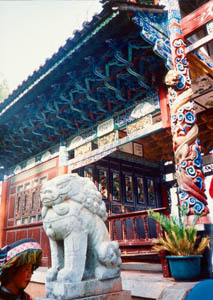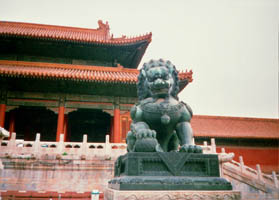|
All the Tease in China
Beijing
by Sarah Shuckburgh
Scheming concubines and
pampered little emperors sum up Beijing's imperial past -
and its present, says Sarah Shuckburgh.
As a concubine myself - concubine notoire - being the
common-law partner of a Frenchman - I find myself drawn to
my real, Chinese counterparts. Therefore, on our first day
in Beijing, we head straight for the palace that, for 500
years, was home to royal concubines without number.
The Forbidden City is a series of courtyards, halls and
9,999 rooms in 800 buildings. Surrounded by a deep moat, the
palace was forbidden to all who lived outside, while
concubines, brought in as young girls, were never permitted
to leave, and remained within the palace walls until they
died.
 The wooden palace buildings are exuberant and thrilling. The
tips of every red and yellow roof are peopled with
mysterious lines of little figures, silhouetted against the
sky - auspicious processions of birds, animals, mythical
beasts and humans, striding purposely towards each upturned
roof edge. The wooden palace buildings are exuberant and thrilling. The
tips of every red and yellow roof are peopled with
mysterious lines of little figures, silhouetted against the
sky - auspicious processions of birds, animals, mythical
beasts and humans, striding purposely towards each upturned
roof edge.
Peoples Liberation Army guards stare impassively as we step
inside. The lofty halls are dark and overpowering, heavily
decorated in red and gold and lacquer. In contrast, the
imperial apartments seem small - pokey box-beds lurk in dark
chambers round modest courtyards. For centuries, the harem
was catalogued on dozens of jade tablets in one of these
rooms. Each evening the emperor would select a tablet, and
the chosen concubine would be carried in by eunuchs, her
naked body and tiny bound feet draped in yellow - the
immortal colour that only the emperor might use.
A concubine's eternal hope was that she would become a
favourite. Cixi, the formidable Dragon Lady, started as one
of Emperor Xianfeng's junior concubines, but after his death
in 1861 she became the all-powerful Dowager Empress, a
position she held for 47 years, appointing, as emperor,
first her five-year-old son, then (after his death) her
three-year-old nephew, and then (after his death, while
imprisoned by the Empress in the Forbidden City), a young
great-nephew - who became the Last Emperor.
We peer at a small throne and, behind a curtain, the Dragon
Lady's much grander throne, from which she would hiss
instructions to the boy-emperor during royal audiences.
Next, we visit the Summer Palace, rebuilt by the Dragon Lady
with money intended for the navy - including, as her
little joke, a full-sized ornamental boat made of marble. We
marvel at her 900-yard covered way, decorated with
8,000 paintings.
As the light fails, we travel by rickshaw through the narrow
streets of hutongs, traditional old quadrangle houses.
Although many new apartments in Beijing have bathrooms and
kitchens, most hutongs still have no plumbing - waste from
public wash houses and lavatories is emptied into carts.
Alleyways are cluttered with washing and rubbish. Men squat
outside bicycle repair shops. Tiny shops display sacks of
rice, heaps of brown roots. Older men and women perch on low
walls, playing Chinese checkers.
On the pavement, a barber is cutting hair, a sheet wrapped
round his customers' shoulders. There are few children - the
one-child policy is strictly enforced. An old lady totters
slowly by, leaning on a stick. Her feet are hobbled and
stunted - lingering evidence of centuries of binding baby
girls' feet, a practice theoretically banned since 1912.
 Our rickshaws drop us at the palace of the Dragon Lady's
favourite, Prince Gong, now the Beijing Music Academy, home
to the Peking Opera. We are escorted through a curtain to a
ramshackle backstage area, where the leading lady sits on a
stool, peering at her dimly-lit reflection in a tarnished
mirror. Our rickshaws drop us at the palace of the Dragon Lady's
favourite, Prince Gong, now the Beijing Music Academy, home
to the Peking Opera. We are escorted through a curtain to a
ramshackle backstage area, where the leading lady sits on a
stool, peering at her dimly-lit reflection in a tarnished
mirror.
Operas were traditionally performed in noisy teahouses, and
we take our seats round a table, and sip tea and nibble
steamed cakes as the performance begins. Just beside us,
musicians suddenly produce a weird, deafening cacophony on
two-stringed fiddles, wooden whistles and flutes, side-drum
and cymbals - and onto the empty stage shuffles our leading
lady, beneath a projected surtitle which says "The Drunken
Concubine".
She is resplendent in silver and red robes, with sleeves
dangling to the ground, a headdress that sprouts four-foot
tendrils, and pom-pom slippers. As incomprehensible bangs
and crashes emanate from the orchestra, the leading lady
starts a raucous caterwauling - a totally alien din of
piercing noises. She takes tiny steps forward, cocks her
head at the audience, flicks a sleeve over a forearm, and
screeches some more. I grasp the plot from the surtitles
(the Emperor has rejected her for another concubine) but I
quickly become aware that each ear-splitting squawk and
jerky gesture has a symbolic and deeply affecting meaning to
the enraptured audience around me.
Finally, with more screeches, grimaces, gestures and
shuffles, the discarded concubine exits, to spend the rest
of her life imprisoned in the Forbidden City.
But are there emperors or concubines today? Yes, today's
Chinese emperors are the doted-upon baby boys. Everywhere,
we see top-heavy families of grandparents and parents,
drably dressed in grey and black, gazing adoringly at a
plump, cosseted toddler. The xiao huangdi, or Little
Emperor, autocratic ruler of the family, is invariably
extravagantly decked out in red and silver brocade jacket,
fur-trimmed hat, pointy-toed slippers, and strange trousers
split up the back to reveal naked buttocks.
As for concubines, it seems that they, too, are reappearing
with China's increasing affluence, consumerism and free
enterprise. My own concubin notoire, Guillame, speaks
Chinese, and as I struggle to lift pork-filled dumplings
with chopsticks, he eavesdrops a conversation at the next
table. A middle-aged, elegantly suited man is discussing
with his glamorous young lover the flat that he has just
bought her.
She says she wants a car. I take a furtive look at her as I
sip my wonton soup. I know what am I am seeing - a
21st-century Dragon Lady.
First published by the Telegraph
©SarahShuckburgh |